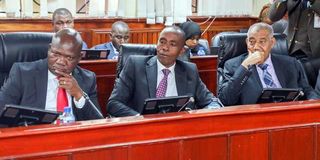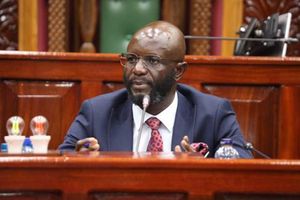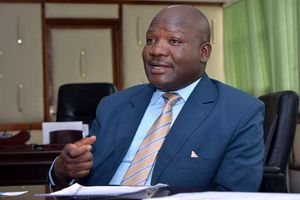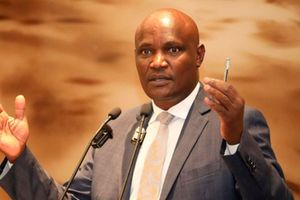
Kakamega governor Fernandes Barasa (left), Kiambu governor Kimani Wamatangi (centre) and his Lamu counterpart Issa Timamy when they appeared before the Senate Finance and Budget Committee on April 3, 2025, to deliberate on the revenue sharing proposal.
A proposed new revenue sharing formula for counties by the Commission on Revenue Allocation (CRA) now risks running into headwinds with governors and senators opposed to the system.
The development comes after the Council of Governors (CoG) called for either dismissal or a complete overhaul of the formula, known as the fourth basis for revenue sharing, calling it “flawed and discriminative”.
Senators root for retention of the current formula, which is supposed to be used for the last time in the financial year ending June 30, 2025.
Appearing before the Senate committee on Finance and Budget on Thursday, the governors called for a revision of the proposed formula.
The committee led by Mandera Senator Ali Roba is currently considering the new formula which will guide the sharing of resources among 47 devolved units for another five years starting in the financial year ending June 30, 2026.
Led by CoG’s Finance Committee Chairperson Fernandes Barasa, the county chiefs argued that the formula is “skewed” and, therefore should be dismissed by the Senate.
“The Senate should dismiss or cause for a complete overhaul of the proposed formula. This is because we feel that it is flawed and discriminatory,” said governor Barasa.
“We cannot have a formula that is going to disadvantage other counties. The Council of Governors emphasises the importance of a fair, transparent, and efficient fourth basis for revenue sharing,” he added. The governors argued that some of the parameters captured in the proposed formula are vague, not scientific, too academic, and impractical, calling for changes on the same.
According to the formula, CRA has assigned the population the biggest weight at 42 per cent but in the current formula, the population weighs 18 per cent.
The population was weighted at 45 per cent in the second-generation formula, while it was weighted at 45 per cent in the first framework. Geographical size has been given a weight of nine per cent from the current eight.
Equal share has been given a weight of 22 per cent from the current 20 while the weight for the poverty index has been retained at 14 per cent.
The third basis, which has been in place since the fiscal year ending June 2021, retained 50 per cent of the second basis allocation from the financial year ended June 2020 with revenue allocation considering multiple population-based indices, including health, agriculture, roads, and poverty.
For the proposed fourth basis, CRA has suggested additional parameters including the blue economy, economic growth, water and sanitation, fiscal effort, and prudence.
Other factors to be considered include affirmative action for small counties, environmental performance, security, infrastructure needs, early childhood development, disease prevalence, afforestation, and urban service costs.
“To facilitate service delivery, the recommendation provides for an equal minimum allocation across all counties, using population and geographical size of a county as the key transfer parameters,” CRA Chairperson Mary Chebukati said.
CRA has introduced the income distance index and assigned it a weight of 13 per cent together with poverty parameters as measures of inequality among county governments in order to address economic disparities and promote development.
However, the governors took issue with the new parameter of the income distance, saying that it was not only subjected to public participation but was also arbitrary and unreasonable.
“The parameter on income distance should be elaborated and subjected to a wider stakeholder engagement or dropped for a more widely acceptable parameter,” governor Barasa said.

The National Treasury Building in Nairobi.
The governors said the parameter may disincentivise economic activity since the Counties with lower economic output are getting significantly higher allocations and further compound income and productivity inequalities in the long run.
On the poverty index, the governors said the parameter only seeks to reward poverty, adding the framework had a sunset clause.
“We should not be seen to be rewarding poverty…. that the poorer you are the more money you get,” Mombasa Governor Abdulswamad Nassir said.
Kakamega Senator Boni Khalwale, while hinting at the senate retaining the current formula, sought the opinion of the governors on the proposal to retain the current formula.
“In South Africa, they retain a formula for 10 years. What will be your opinion if we recommend the retention of the current formula?” Mr Khalwale posed.
The governor said they would support the retention of the current formula provided it guarantees that no county would lose revenue.
With the Senate united in rejecting CRA’s proposal, the Commission may be forced to revise the revenue-sharing formula
A final decision will depend on negotiations between CRA, the Senate, the National Treasury, and county governments in the coming months.












